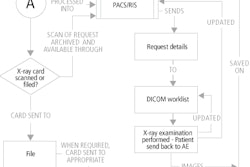Facilities that install integrated RIS/PACS networks can make good use of the Integrating the Healthcare Enterprise (IHE) integration profiles during the acceptance testing process, according to researchers from Montefiore Medical Center in New York City.
"These profiles can and likely should be used not just operationally, but also ... to determine if a system or component is functioning properly," said Dr. Nogah Haramati. He discussed the benefits of employing integration profiles from the RSNA’s and HIMSS’ IHE initiative during a scientific session at the 2003 RSNA meeting in Chicago.
In the traditional PACS acceptance-testing process, testing criteria focused on image transmission, retrieval, display, and manipulation, Haramati said. RIS acceptance criteria focused on performing certain procedures, such as time to display worklists, etc.
The goal for an integrated RIS/PACS environment, however, is more efficient workflow and integration, not simply improved inter-system communications, Haramati said.
"Integration is really a state where the users are not or should not be aware of what system they’re actually functioning in," he said. "Users just want to accomplish their tasks in the most efficient and effective manner."
IHE integration profiles bring unified solutions to real-world integration problems, Haramati said. The IHE profiles defines a ‘phrasebook’ that solves real-world problems by assembling the pieces provided by DICOM, HL7, and other standards, he said.
"IHE stipulates the terms of the transactions, leaving nothing to interpretation," he said.
While the actual functioning of a RIS and PACS network varies depending on whether the workflow is RIS-centric or PACS-centric, IHE makes roles available to all actors (systems that perform a function) in the process. These roles can be allocated to any vendor, he said. Each profile comprises the architectural workflows relating to that profile; IHE compliance can be verified by following the workflow in the profile and assuring that every actor’s role is fulfilled by the appropriate vendor.
The use of IHE profiles for acceptance testing offers several advantages, Haramati said. Testing procedures can’t be rigged or "fixed" by the vendor, and will mirror the exact functionality that was purchased. In addition, testing procedures assure that all of the actors, regardless of vendor source, are working together.
"IHE defines what our deliverable is, and it defines how we will test it," he said.
While additional acceptance testing parameters still need to be generated for all areas not covered by IHE, incorporating the IHE profiles makes for a more thorough testing process, he said.
MMC has completed development of its acceptance testing criteria with its vendors, and plans to complete the testing process by September 2004, Haramati said.
By Erik L. RidleyAuntMinnie.com staff writer
January 12, 2004
Related Reading
IHE, HL7 plan joint demo, August 27, 2003
IHE pursues user adoption, product development, IT expansion, May 12, 2003
IHE eyes real-world applications at RSNA, plans new IT committees, December 1, 2002
IHE expands into new domains in Year 4, April 3, 2002
IHE boosts systems integration prospects, January 30, 2002
Copyright © 2004 AuntMinnie.com



















